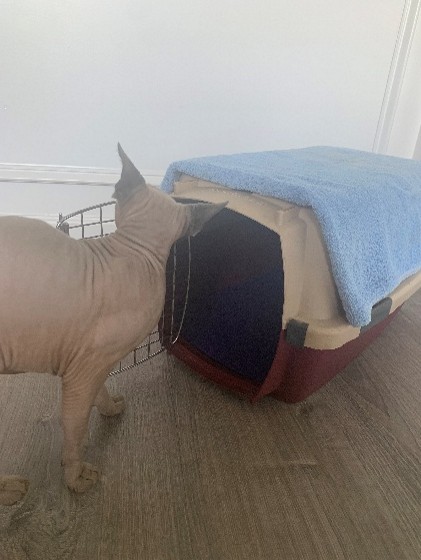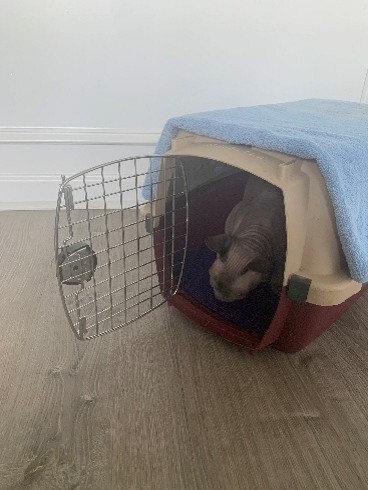Marianne Manning, RVT, LVT, KPA CTP, LSHC-S, Elite FFCP (Veterinary), CFVP, VTS (Behavior)
cat1.jpg - Caption. [Optional]
![cat1.jpg - Caption. [Optional] A cat peers out from their carrier](/AppUtil/Image/handler.ashx?imgid=8952732)
Image courtesy of Marianne Manning, RVT, LVT, KPA CTP, LSHC-S, Elite FFCP (Veterinary), CFVP, VTS (Behavior)
Teaching your cat to enter their carrier on their own is the first step in making veterinary visits less stressful. When a pet caregiver brings the carrier out from a closet or basement, the cat remembers past experiences and may run and hide. If your cat is already stressed about going into the carrier, that stress will increase during the car ride, in the waiting room, and during the exam. Training your cat to use the carrier also helps in emergencies, such as a fire or natural disaster, when you need to move them quickly.
Training methods such as operant conditioning, shaping, and marker training can be used to teach your cat to go into their carrier. Operant conditioning means that consequences shape a behavior. Your cat learns that certain behaviors get rewards, making them want to repeat the behavior. In carrier training, the method used is positive reinforcement, which rewards your cat for moving closer to the carrier. Shaping means breaking down the behavior in small steps, such as first looking toward the carrier, then stepping inside. A marker, such as a clicker, helps your cat understand the exact moment they did the right thing. Food or treats are usually given after the click to let your cat know what behavior earned them the reward.
Start teaching your cat to enter their carrier by leaving the carrier in a room with the door open. Sit close to the carrier so you can give treats, and later, when your cat is ready, close the door and lift the carrier.
Phase 1: Looking at the Carrier
Mark and reward each of these steps. Give the treat outside the carrier. Click as your cat:
- Looks at or turns towards the carrier.
- Takes steps towards the carrier.
- Walks closer to the carrier door.
- Stands in front of the carrier.
- Looks into the carrier.
Phase 1

Phase 1: Image courtesy of Marianne Manning, RVT, LVT, KPA CTP, LSHC-S, Elite FFCP (Veterinary), CFVP, VTS (Behavior)
Phase 2: Starting to Enter
Keep giving the treat outside the carrier. Click when your cat:
- Leans inside the carrier.
- Puts their head and shoulders inside.
- Puts one paw inside.
- Puts both paws inside.
cat3.jpg - Caption. [Optional]
![cat3.jpg - Caption. [Optional] A cat puts just his head inside a carrier](/AppUtil/Image/handler.ashx?imgid=8952778)
PHASE 2: Image courtesy of Marianne Manning, RVT, LVT, KPA CTP, LSHC-S, Elite FFCP (Veterinary), CFVP, VTS (Behavior)
|
cat4.jpg - Caption. [Optional]
![cat4.jpg - Caption. [Optional] A cat approches a carrier and puts one foot and his head inside](/AppUtil/Image/handler.ashx?imgid=8952783)
PHASE 2: Image courtesy of Marianne Manning, RVT, LVT, KPA CTP, LSHC-S, Elite FFCP (Veterinary), CFVP, VTS (Behavior)
|
Phase 3: Going All the Way in
Click for each step, with the treat given outside the carrier:
- Placing three to four paws inside.
- Walking all the way in.
- Turning around inside the carrier.
- Sitting or lying down in the carrier.
cat5.jpg - Caption. [Optional]
![cat5.jpg - Caption. [Optional] Cat steps all the way in the carrier](/AppUtil/Image/handler.ashx?imgid=8952797)
PHASE 3: Image courtesy of Marianne Manning, RVT, LVT, KPA CTP, LSHC-S, Elite FFCP (Veterinary), CFVP, VTS (Behavior)
Phase 4: Adding a Cue
Choose a verbal cue, such as “vet”, or use a gesture. Continue giving the treat outside the carrier.
- Say “vet” as your cat walks into the carrier. Click when they sit facing the doorway.
- Repeat the step five to 10 times.
- Test the cue by saying “vet” when your cat is not near the carrier. Click when they go inside.
- Say “vet” and click when they sit inside facing the doorway.
cat6.jpg - Caption. [Optional]

PHASE 4: Image courtesy of Marianne Manning, RVT, LVT, KPA CTP, LSHC-S, Elite FFCP (Veterinary), CFVP, VTS (Behavior)
Phase 5: Practice Time Inside
Now, start giving the treat inside the carrier. Click when your cat:
- Sits inside for one to two seconds.
- Sits for three to five seconds.
- Stays inside while you reach for the door.
- Stays inside while you close the door partway.
cat7.jpg - Caption. [Optional]
![cat7.jpg - Caption. [Optional] Cat in open-door carrier looking out with interest](/AppUtil/Image/handler.ashx?imgid=8952849)
PHASE 5: Image courtesy of Marianne Manning, RVT, LVT, KPA CTP, LSHC-S, Elite FFCP (Veterinary), CFVP, VTS (Behavior)
Phase 6: Closing the Door
Keep treating inside the carrier while you:
- Close the door without latching.
- Close and latch the door.
- Close and latch the door, then wait one to five seconds before clicking.
cat8.jpg - Caption. [Optional]
![cat8.jpg - Caption. [Optional] Hand closing door of the cat carrier with cat inside](/AppUtil/Image/handler.ashx?imgid=8952855)
PHASE 6: Image courtesy of Marianne Manning, RVT, LVT, KPA CTP, LSHC-S, Elite FFCP (Veterinary), CFVP, VTS (Behavior)
Phase 7: Picking up the Carrier
Click and treat inside the carrier as you:
- Lift the carrier a few inches.
- Lift the carrier a few feet off the floor.
- Hold the carrier fully off the ground.
- Walk around while carrying the carrier.
You can place a towel or blanket over the carrier at this stage to block your cat’s view. This can lower stress during travel and in the waiting room, and may prevent motion sickness. Use a feline pheromone spray on the towel before your cat goes inside. You may need to repeat earlier phases when adding the towel, but your cat should move faster through the steps they already know.
The final stage is traveling. Start by placing the carrier in the car. Next, close the door, turn on the car, and practice with short rides. Give your cat a treat or a lick mat in the carrier so it can associate car rides with something positive. Food can be used to gauge how stressed your cat feels. If your cat is willing to eat, that is a sign that they feel less stressed.
Teaching your cat to go into a carrier independently and feel comfortable at each step makes veterinary visits much less stressful for you and your cat. Adding a cue for entering the carrier removes pressure and prevents damaging the bond you share, because your cat is not being forced. Carrier training can be a fun and rewarding behavior to teach and should always be a positive experience for everyone involved.
cat9.jpg - Caption. [Optional]
![cat9.jpg - Caption. [Optional] Cat carrier door is completelt closed with cat inside](/AppUtil/Image/handler.ashx?imgid=8952860)
PHASE 7: Image courtesy of Marianne Manning, RVT, LVT, KPA CTP, LSHC-S, Elite FFCP (Veterinary), CFVP, VTS (Behavior)